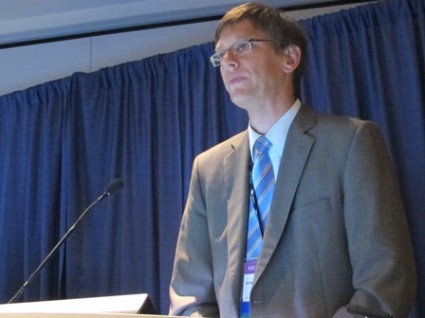User login
CHICAGO – The combination of bevacizumab and irinotecan far outshone tenozolomide in delaying disease progression among patients with MGMT-unmethylated glioblastoma, an investigator reported at the annual meeting of the American Society of Clinical Oncology.
In the phase II GLARIUS trial, 79.6% of patients treated with bevacizumab (Avastin) and irinotecan (Camptosar) were free of progression at 6 months, compared with 41.3% of patients randomized to receive temozolmide (Temodar) (P less than .0001), reported Dr. Ulrich Herrlinger from the department of neurology at University Clinic of Bonn, Germany.
Progression-free survival at 6 months (PFS-6) was the study's primary endpoint.
A preliminary analysis also hinted at a potential overall survival advantage for the bevacizumab-irinotecan (BEV/IRI) combination. After nearly 50% of patients in each arm had died, median overall survival was 16.6 months for the BEV/IRI group, compared with 14.8 months for the temozolomide group (hazard ratio, 0.60; P = .031).
"Obviously we did not harm our patients by omitting temozolomide and choosing something different, BEV/IRI, for treating these patients," Dr. Herrlinger said.
The combination is a promising alternative to temozolomide therapy in patients with with MGMT (O6-methylguanine-DNA methyltransferase)-unmethylated glioblastoma, he said. About 55%-65% of newly diagnosed glioblastomas are not methylated by MGMT, a DNA repair enzyme, and these have a worse prognosis than those in which MGMT promotes methylation, according to Dr. Herrlinger.
Investigators at 22 centers in Germany tested patients with glioblastoma for MGMT status, and randomized a total of 182 patients with newly diagnosed, histologically confirmed MGMT-unmethylated glioblastoma. Of these, 170 received at least one course of drug therapy and were evaluable for response; these patients were included in the analysis.
All patients received 60 Gy localized radiation in 30 fragments of 2 Gy each. They were randomized 2:1 to BEV-IRI (116 patients) or temozolomide (54 patients).
The experimental arm received bevacizumab 10 mg/kg every 2 weeks during radiotherapy followed by maintenance bevacizumab at the same dose and irinotecan 125 mg/m2 every 2 weeks without or with enzyme-inducing antiepileptic drugs at a dose of 340 mg/m2. The standard therapy arm was given temozolomide 75 mg/m2 daily during radiotherapy, followed by 6 courses of temozolomide 150-200 mg/m2 for 5 days every 4 weeks.
In addition to the advantage in progression-free survival at 6 months, median progression-free survival also was longer with BEV/IRI: 9.74 months vs. 6 months in patients treated with temozolomide (HR 0.30, P less than .0001).
In addition patients on the combination used fewer mean daily steroids than patients on temozolomide.
The safety analysis showed that grade 3 or 4 vascular disorders – including deep vein thrombosis, pulmonary embolism, and hypertension – occurred in 10.9% of patients on BEV/IRI, compared with 3.6% of those on temozolomide. The combination was also associated with more grade 3 or 4 diarrhea and nausea, wound infections, and proteinuria. However, hematotoxicity was higher among patients on temozolomide, occurring in 14.8%, compared with 1.7% of patients on BEV/IRI.
"I think it’s important to recognize that there is a [bevacizumab] toxicity signal," said Dr Albert Lai, a neuro-oncologist at the University of California, Los Angeles, who was the invited discussant.
Dr. Lai commented that the overall survival signal seen by the GLARIUS investigators may have been affected by an optional crossover to BEV/IRI after disease progression on temozolomide. Of the 54 patients in the temozolomide arm, 29 crossed over to BEV/IRI.
The GLARIUS trial was sponsored by Hoffman-La Roche. Dr. Herrlinger disclosed being a consultant and speaker and receiving research support from the company. Dr. Lai disclosed serving as a consultant and receiving research funding from Genentech/Roche.
CHICAGO – The combination of bevacizumab and irinotecan far outshone tenozolomide in delaying disease progression among patients with MGMT-unmethylated glioblastoma, an investigator reported at the annual meeting of the American Society of Clinical Oncology.
In the phase II GLARIUS trial, 79.6% of patients treated with bevacizumab (Avastin) and irinotecan (Camptosar) were free of progression at 6 months, compared with 41.3% of patients randomized to receive temozolmide (Temodar) (P less than .0001), reported Dr. Ulrich Herrlinger from the department of neurology at University Clinic of Bonn, Germany.
Progression-free survival at 6 months (PFS-6) was the study's primary endpoint.
A preliminary analysis also hinted at a potential overall survival advantage for the bevacizumab-irinotecan (BEV/IRI) combination. After nearly 50% of patients in each arm had died, median overall survival was 16.6 months for the BEV/IRI group, compared with 14.8 months for the temozolomide group (hazard ratio, 0.60; P = .031).
"Obviously we did not harm our patients by omitting temozolomide and choosing something different, BEV/IRI, for treating these patients," Dr. Herrlinger said.
The combination is a promising alternative to temozolomide therapy in patients with with MGMT (O6-methylguanine-DNA methyltransferase)-unmethylated glioblastoma, he said. About 55%-65% of newly diagnosed glioblastomas are not methylated by MGMT, a DNA repair enzyme, and these have a worse prognosis than those in which MGMT promotes methylation, according to Dr. Herrlinger.
Investigators at 22 centers in Germany tested patients with glioblastoma for MGMT status, and randomized a total of 182 patients with newly diagnosed, histologically confirmed MGMT-unmethylated glioblastoma. Of these, 170 received at least one course of drug therapy and were evaluable for response; these patients were included in the analysis.
All patients received 60 Gy localized radiation in 30 fragments of 2 Gy each. They were randomized 2:1 to BEV-IRI (116 patients) or temozolomide (54 patients).
The experimental arm received bevacizumab 10 mg/kg every 2 weeks during radiotherapy followed by maintenance bevacizumab at the same dose and irinotecan 125 mg/m2 every 2 weeks without or with enzyme-inducing antiepileptic drugs at a dose of 340 mg/m2. The standard therapy arm was given temozolomide 75 mg/m2 daily during radiotherapy, followed by 6 courses of temozolomide 150-200 mg/m2 for 5 days every 4 weeks.
In addition to the advantage in progression-free survival at 6 months, median progression-free survival also was longer with BEV/IRI: 9.74 months vs. 6 months in patients treated with temozolomide (HR 0.30, P less than .0001).
In addition patients on the combination used fewer mean daily steroids than patients on temozolomide.
The safety analysis showed that grade 3 or 4 vascular disorders – including deep vein thrombosis, pulmonary embolism, and hypertension – occurred in 10.9% of patients on BEV/IRI, compared with 3.6% of those on temozolomide. The combination was also associated with more grade 3 or 4 diarrhea and nausea, wound infections, and proteinuria. However, hematotoxicity was higher among patients on temozolomide, occurring in 14.8%, compared with 1.7% of patients on BEV/IRI.
"I think it’s important to recognize that there is a [bevacizumab] toxicity signal," said Dr Albert Lai, a neuro-oncologist at the University of California, Los Angeles, who was the invited discussant.
Dr. Lai commented that the overall survival signal seen by the GLARIUS investigators may have been affected by an optional crossover to BEV/IRI after disease progression on temozolomide. Of the 54 patients in the temozolomide arm, 29 crossed over to BEV/IRI.
The GLARIUS trial was sponsored by Hoffman-La Roche. Dr. Herrlinger disclosed being a consultant and speaker and receiving research support from the company. Dr. Lai disclosed serving as a consultant and receiving research funding from Genentech/Roche.
CHICAGO – The combination of bevacizumab and irinotecan far outshone tenozolomide in delaying disease progression among patients with MGMT-unmethylated glioblastoma, an investigator reported at the annual meeting of the American Society of Clinical Oncology.
In the phase II GLARIUS trial, 79.6% of patients treated with bevacizumab (Avastin) and irinotecan (Camptosar) were free of progression at 6 months, compared with 41.3% of patients randomized to receive temozolmide (Temodar) (P less than .0001), reported Dr. Ulrich Herrlinger from the department of neurology at University Clinic of Bonn, Germany.
Progression-free survival at 6 months (PFS-6) was the study's primary endpoint.
A preliminary analysis also hinted at a potential overall survival advantage for the bevacizumab-irinotecan (BEV/IRI) combination. After nearly 50% of patients in each arm had died, median overall survival was 16.6 months for the BEV/IRI group, compared with 14.8 months for the temozolomide group (hazard ratio, 0.60; P = .031).
"Obviously we did not harm our patients by omitting temozolomide and choosing something different, BEV/IRI, for treating these patients," Dr. Herrlinger said.
The combination is a promising alternative to temozolomide therapy in patients with with MGMT (O6-methylguanine-DNA methyltransferase)-unmethylated glioblastoma, he said. About 55%-65% of newly diagnosed glioblastomas are not methylated by MGMT, a DNA repair enzyme, and these have a worse prognosis than those in which MGMT promotes methylation, according to Dr. Herrlinger.
Investigators at 22 centers in Germany tested patients with glioblastoma for MGMT status, and randomized a total of 182 patients with newly diagnosed, histologically confirmed MGMT-unmethylated glioblastoma. Of these, 170 received at least one course of drug therapy and were evaluable for response; these patients were included in the analysis.
All patients received 60 Gy localized radiation in 30 fragments of 2 Gy each. They were randomized 2:1 to BEV-IRI (116 patients) or temozolomide (54 patients).
The experimental arm received bevacizumab 10 mg/kg every 2 weeks during radiotherapy followed by maintenance bevacizumab at the same dose and irinotecan 125 mg/m2 every 2 weeks without or with enzyme-inducing antiepileptic drugs at a dose of 340 mg/m2. The standard therapy arm was given temozolomide 75 mg/m2 daily during radiotherapy, followed by 6 courses of temozolomide 150-200 mg/m2 for 5 days every 4 weeks.
In addition to the advantage in progression-free survival at 6 months, median progression-free survival also was longer with BEV/IRI: 9.74 months vs. 6 months in patients treated with temozolomide (HR 0.30, P less than .0001).
In addition patients on the combination used fewer mean daily steroids than patients on temozolomide.
The safety analysis showed that grade 3 or 4 vascular disorders – including deep vein thrombosis, pulmonary embolism, and hypertension – occurred in 10.9% of patients on BEV/IRI, compared with 3.6% of those on temozolomide. The combination was also associated with more grade 3 or 4 diarrhea and nausea, wound infections, and proteinuria. However, hematotoxicity was higher among patients on temozolomide, occurring in 14.8%, compared with 1.7% of patients on BEV/IRI.
"I think it’s important to recognize that there is a [bevacizumab] toxicity signal," said Dr Albert Lai, a neuro-oncologist at the University of California, Los Angeles, who was the invited discussant.
Dr. Lai commented that the overall survival signal seen by the GLARIUS investigators may have been affected by an optional crossover to BEV/IRI after disease progression on temozolomide. Of the 54 patients in the temozolomide arm, 29 crossed over to BEV/IRI.
The GLARIUS trial was sponsored by Hoffman-La Roche. Dr. Herrlinger disclosed being a consultant and speaker and receiving research support from the company. Dr. Lai disclosed serving as a consultant and receiving research funding from Genentech/Roche.
AT ASCO ANNUAL MEETING 2013
Major finding: The 6-month progression-free survival 6 months after randomization was 79.6% for patients treated with bevacizumab and irinotecan vs. 41.3% with temozolomide.
Data source: Randomized controlled trial in 170 patients with MGMT-unmethylated glioblastoma from 22 centers in Germany.
Disclosures: The GLARIUS trial was sponsored by Hoffman-La Roche. Dr. Herrlinger disclosed being a consultant and speaker and receiving research support from the company. Dr. Lai disclosed serving as a consultant and receiving research funding from Genentech/Roche.

